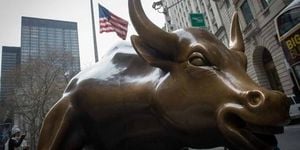Influencers are having their moment—not just on social media but also as pivotal players across various industries, particularly entertainment and commerce. This evolution is highlighted by publications like The Hollywood Reporter, which recently unveiled its inaugural "Creator A-List," showcasing the most influential content creators of 2024. But as these individuals rise to fame, they face unique challenges stemming from the volatile nature of their careers.
The "Creator A-List" features 50 social media stars who have captivated audiences and garnered massive followings, ranging from talented TikTokers to Instagram luminaries. The Hollywood Reporter emphasizes the substantial impact these influencers have on shaping trends and consumer culture. Yet, as the list reflects, many commenters noted unfamiliarity with several names, sparking debates about who holds true influence today.
Leading up to the reveal of this A-List, the industry has seen various trends, including the increasing role of influencers at major movie premieres and promotional events. Influencer Easton Simpson, for example, created memorable content for the Kingdom of the Planet of the Apes premiere, mixing humor with celebrity interviews. His approach—a comedic mumble during interviews—went viral, racking up millions of views and highlighting how unconventional tactics can attract attention. Despite facing backlash over perceived disrespect, Simpson noted how many fans discovered the film through his videos, examining the dynamic relationship between influencers and studios.
This observation points to the precarious nature of influencer fame today. "It’s not just about going viral; being known is tied to the ever-shifting algorithms of social media platforms," commented Josh Helfgott, TikTok star and influencer. Indeed, what many creators once enjoyed as straightforward success has morphed. Today, as Helfgott expressed, maintaining visibility on platforms like TikTok and Instagram requires agility and adaptability. "Creating content this year is more difficult and competitive than ever," he noted, reflecting the pressures felt across the influencer spectrum.
At the heart of the rise of influencers is the so-called "creator economy," estimated by Goldman Sachs to exceed half a trillion dollars by 2027. This ecosystem comprises not just influencers themselves but extends to various industries, as their revenue streams diversify. Savvy creators are finding ways to blend their online presence with traditional avenues, including merchandise collaborations and content creation for mainstream media. Josh Helfgott, after achieving TikTok success, leveraged his popularity to engage with major brands and explore opportunities like merchandise creation.
It's not all glitzy, though. The lifestyle pressures and mental strain can be overwhelming. A significant percentage of influencers report struggles with burnout, and many grapple with the emotional labor of maintaining audience engagement and meeting expectations. A 2022 study indicated 90% of content creators experience burnout, with over 70% considering quitting entirely. The digital space, often perceived as glamorous, can exact significant tolls on mental health.
For creators of color, the challenges deepen. A report from the SevenSix Agency found stark disparities within compensation, with creators identifying as having darker skin tones earning significantly less than their lighter-skinned counterparts. These creators might face fewer brand partnerships, receive limited product promotions, and navigate explicit biases, similarly affecting their economic opportunities and visibility within the creator economy.
Despite the difficulties, many influencers find ways to carve out sustainable roles within this new labor reality. Experts urge aspiring creators to leverage their platforms multilaterally, spreading content across different channels instead of locking themselves to just one. This is precisely what Brittany Broski did, who is now thriving on YouTube after generating buzz with her kombucha reaction video five years ago, allowing her to launch shows and diversify her income sources.
While the industry brims with opportunity, many influencers are also urged to maintain their authenticity. This means not merely capitalizing on fleeting trends but cultivating relatable content as seen with creators like Alix Earle. The young influencer saw her authenticity shine through her relatable TikTok videos, growing her presence even after experiencing controversy. By focusing on her audience's interests and remaining genuine, Earle continues to attract attention from brands, reflective of the need for authenticity within the influencer space.
Caitlin Lutz, co-founder of the Creator Collective Agency, emphasizes this point. "+We’ve witnessed creators overly tethered to their launch platform, making it challenging to pivot when their following starts to dwindle. Broadening their horizon and experimenting with fresh content formats is key to thriving," she stated, reiteratively underscoring the balance between authenticity, consistency, and refraining from over-saturation.
Beyond individuals are growing lists of digital stars making waves. For every well-established influencer like MrBeast or Emma Chamberlain, countless up-and-comers are finding innovative ways to connect and engage audiences. Adam Faze, founder of the content studio Gymnasium, shared insights about the longevity of modern creators, whose influence transcends traditional media boundaries. Faze remarked, "I initially produced shows for television. Now, I leverage platforms young people engage with—that's where the audience is!"
This duality of fame—between the glimmer of rapid success and the struggles faced—started discussions on how Hollywood and marketing companies perceive influencer roles moving forward. "Every brand wants to be associated with the latest flavors of social media fame to boost visibility and authenticity. Yet, the question remains—is it enough for transactions to be merely based on social standing without considering genuine audience engagement?" mused Adam Goodman, CEO of Invisible Narratives, focusing on the shift marketers must make as they navigate this quicksand of internet celebrity tactics.
Lastly, as The Hollywood Reporter showcased the Creator A-List, it encapsulated the evolution of fame itself. Digital stardom may seem whimsical but is loaded with unpredictability. The power dynamics are shifting, as both new and traditional media vie for market share and audience attention. Could we soon witness shifts from influencer-driven campaigns to multifaceted partnerships reflecting the creators’ unique brand identities? The conversation isn't dying down anytime soon; rather, it’s transitioning, reflecting our changing media consumption habits.
The reality is clear—the influencer space thrives on adaptability, and as trends change, so too must its players. Those who can navigate the tumult will find not just fleeting fame but enduring success, albeit amid challenges like mental health and industry inequality. This new world of content creation is rife with possibilities, but seizing them often means braving the storms of scrutiny, expectation, and the relentless nature of online fame.
The community surrounding creators is marked not merely by follower accounts or viral moments but by resilience through ever-changing tides. Whether charting career paths or simply sharing snippets of their lives, creators wield substantial influence—and with it, the power to shape future dialogues.



